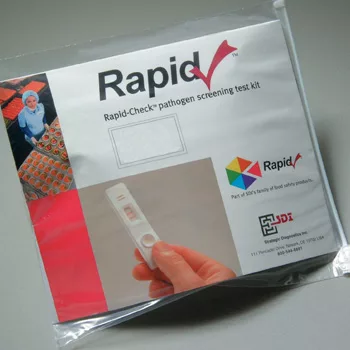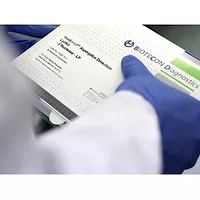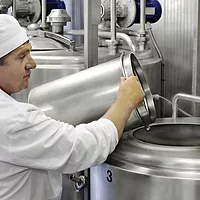The Real Cost of Testing for Salmonella

Salmonella is the most frequently reported foodborne illness in the U.S., according to the U.S. Department of Agriculture (USDA), and is the second most common foodborne illness worldwide. For processors handling foods at high risk for Salmonella contamination, such as raw meat and eggs, getting control of this pathogen should be a primary focus of their food safety program.
Outbreaks of salmonellosis have been reported for decades, but within the past 25 years the disease has increased in incidence on many continents. Salmonella infections cause an estimated 1.4 million human illnesses and 400 deaths annually in the U.S. And while the incidence of other foodborne bacterial infections decreased substantially during 1996—2004, the incidence of Salmonella infections declined only modestly, according to the Centers for Disease Control and Prevention (CDC).
Part of the challenge of getting control over this deadly pathogen is that the Salmonella family includes over 2,300 serotypes of bacteria, 230 of which are commonly found in food. This makes Salmonella a much more complicated pathogen to track and test than other, more specific bacteria.
In response to the need for greater control over all pathogens in the food chain, USDA has focused recently on reducing Salmonella outbreaks. Under USDA’s new science-based inspection system, USDA’s Food Safety and Inspection Service (FSIS) will test meat and poultry samples to identify pathogens, including Salmonella. For the first time ever, FSIS is requiring all plants to reduce bacteria by means of a Hazard Analysis and Critical Control Point (HACCP) plan and accompanying testing and performance standards. These national performance standards will be adjusted downward over time, even further reducing acceptable bacteria levels.
This means that food processing plants, especially those that have had documented incidences of Salmonella contamination and those processing high burden foods, such as meats, vegetables and uncooked foods, will likely be expected to do more Salmonella testing, says George Teaney, senior research scientists at Strategic Diagnostics Inc. (sdix.com). “If there is a rule change from USDA, processors will need to do more testing and they will need high confidence in the results of those tests—and that all translates to added cost for the production process.”
Teaney points out that the vastness and diversity of the Salmonella genus and the diversity of environments in which it is found, makes detection tricky, requiring multiple media or enrichment conditions to ensure that all strains of Salmonella have the opportunity to grow and be detected. “If you use only one set of culture conditions for all food types you may not get all strains of Salmonella to grow.”
This adds time to the process, and many hidden expenses that a lot of processors don’t even recognize. Teaney notes that there are many soft costs associated with a Salmonella testing program, and offers this advice on how to accurately calculate the true price of testing. “Once you know the actual cost of your program you can choose the most effective and most cost-efficient testing methods for your facility,” he says.
Teaney suggests that food processors consider the following five expenses of testing when selecting a rapid microbiology method that is right for their operation:
1. Testing products. Begin by adding up the hard costs, he says. That includes compiling the cost of media and diagnostic tools for every test performed and multiplying that by the number of tests done in a set period of time.
2. Incidentals. Add in the related incidental costs, including tubes, plates, and confirmation media. “These are all low-expense items but when you are running a large number of tests they can add up.”
3. Equipment. Maintenance contracts can also contribute to the overall cost of equipment/testing on a yearly basis. Factor in capital investments in tools such as multiple incubators and autoclaves required for your testing program, and calculate the return on investment over the life of that equipment.
4. Labor. “The additional cost that many facilities completely miss is the labor associated with testing,” Teaney says, noting that many traditional Salmonella testing methods have six to seven handling steps. “You have to factor the time spent every time an operator prepares media, treats samples or transfers media from the incubators. It all takes time and it is rarely factored in when considering the cost of testing.”
5. Latitude. Another hidden cost, the latitude on time to completion of a test can have a huge impact on the cost of production if it isn’t flexible enough to accommodate your schedule, he says. For example, if a poultry processing plant receives a shipment at 5 p.m. and uses a 40-hour test with little or no latitude, the plant will either have to delay testing until the following day, or pay a third shift to come in and read the results. “The more latitude a test offers the less impact it will have on the production process.”
However, none of these factors are relevant if the test isn’t effective, Teaney says. “Performance is obviously the most important attribute.”
He urges users who are evaluating testing methods to pay close attention to the potential for false negatives, especially when considering tests that offer shorter turn around times on enrichment.
“For low burden foods, such as processed foods, deli meats and processed cheeses, 24 hours may be enough, but for high-burden foods, a 24-hour test can be risky,” he says. “Salmonella testing is not a one-size-fits-all process: you have to consider all the facts before choosing the test that best suits your needs.”
sdix.com
Looking for quick answers on food safety topics?
Try Ask FSM, our new smart AI search tool.
Ask FSM →








